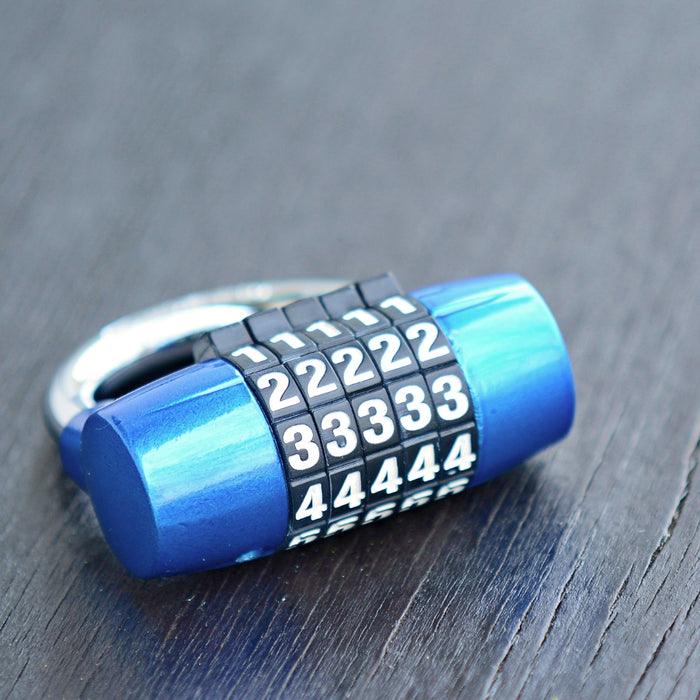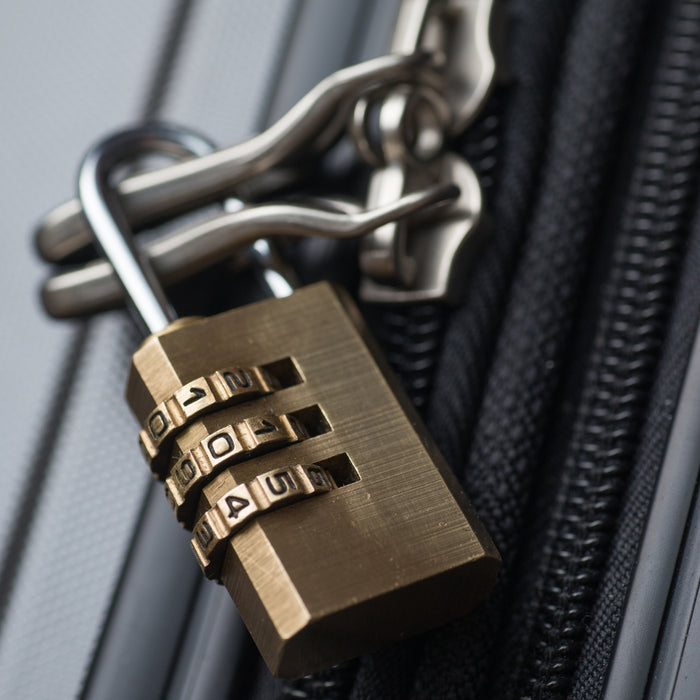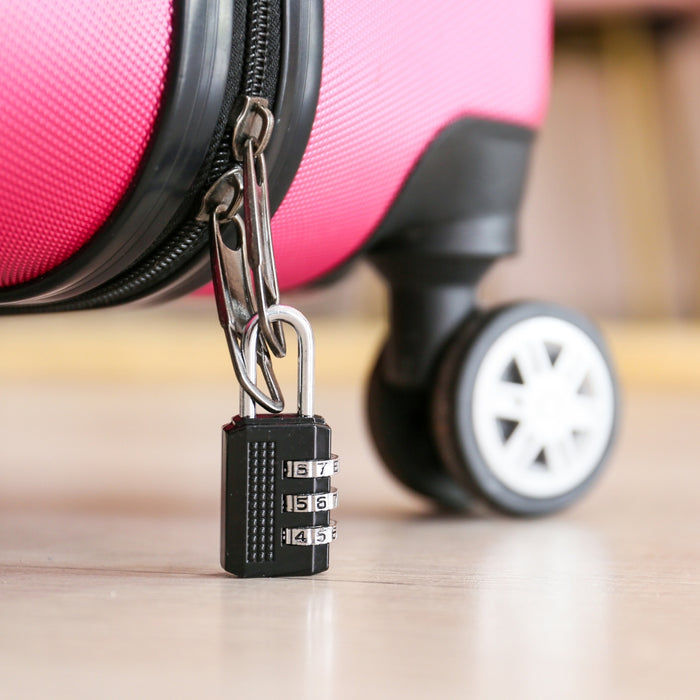

TSA Locks: Your Luggage's Best Friend for Secure Travel
Picture this: you're at the airport, about to embark on your dream vacation. You've packed your bags with care, but there's one thing left to do - secure your luggage. That's where TSA locks come in.
These handy little devices are designed to keep your belongings safe while allowing airport security staff to inspect your bags without damaging the lock. In this post, we'll explore the world of TSA locks and why they're a must-have for any traveller.
If you've ever flown with checked luggage, you've probably noticed those little Travel Sentry Approved (TSA) locks on other people's bags. But what exactly are TSA locks, and how do they differ from regular luggage locks?
- What are TSA locks and how do they work?
- How TSA locks differ from regular locks
- The TSA master key system
- Benefits of using TSA locks
- Choosing the best TSA lock for your luggage
- Types of TSA locks available
- Factors to consider when selecting a TSA lock
- Step-by-step guide to setting and using your TSA lock
- Setting the combination on your TSA lock
- Locking and unlocking your luggage with a TSA lock
- What to do if your TSA lock is damaged or not working properly
- TSA lock compatibility and airline regulations
- Luggage types compatible with TSA locks
- International travel considerations with TSA locks
- Maintaining and troubleshooting your TSA lock
- Cleaning and lubricating your TSA lock
- Common TSA lock issues and how to fix them
- When to replace your TSA lock
- FAQs in relation to TSA locks
- What is the TSA lock?
- Can I use a TSA lock in the UK?
- Can TSA locks be opened?
What are TSA locks and how do they work?
How TSA locks differ from regular locks
Regular luggage locks are great for deterring opportunistic thieves, but they won't do much good if your bag gets flagged for a TSA inspection. If you use a non-TSA approved lock, airport security staff will simply cut it off to access your belongings - leaving your luggage vulnerable for the rest of your trip.
TSA approved locks, on the other hand, can be opened by airport security staff and then relocked once the inspection is complete. This keeps your stuff secure while still allowing TSA to do their job.
The TSA master key system
TSA locks use a special keyway that can be opened with a master key carried by airport security staff. When they need to inspect your bag, they simply use their key to open the lock, rather than resorting to bolt cutters. This master key system allows for a smooth, hassle-free screening process.
Benefits of using TSA locks
Using a TSA lock offers some serious peace-of-mind when checking your luggage. You can travel confidently knowing that your belongings are secure, but also accessible to airport security staff if an inspection is needed.
Plus, using a TSA approved lock means you won't have to worry about your lock being destroyed or your bag being left unlocked during transit. It's a small investment that can save you a lot of headaches in the long run.
Now that you know the benefits of using a TSA lock, you might be wondering how to go about choosing the right one for your needs. With so many options on the market, it can feel a bit overwhelming - but don't worry, we're here to help.
Let's take a look at the different types of TSA locks available, factors to consider when making your selection, and some of the top-rated options.

Choosing the best TSA lock for your luggage
Types of TSA locks available
TSA approved locks come in a few different varieties, each with their own pros and cons. The most common types are:
- Combination locks: These use a numeric code that you set yourself, eliminating the need to carry a key. They're a popular choice for their ease of use.
- Padlocks: These classic locks use a physical key to open and close. Some travellers prefer the familiarity and security of a traditional padlock.
- Cable locks: These feature a flexible steel cable that can be threaded through zippers or around bag handles. They offer an extra level of security and versatility.
Factors to consider when selecting a TSA lock
When choosing a TSA lock, there are a few key factors to keep in mind:
- Durability: Look for locks made from sturdy, high-quality materials that can withstand the rigours of travel. Cheap, flimsy locks are more likely to break or malfunction.
- Ease of use: Consider how easy the lock is to set and open, especially if you'll be using it frequently. Fumbling with a finicky lock while juggling your luggage is no fun.
- Size and weight: If you're an ultralight packer, you may want to opt for a smaller, lightweight lock that won't add bulk to your bag.
- Aesthetics: While it's not the most important factor, some travellers enjoy choosing a lock in a fun colour or design that's easy to spot on the luggage carousel.
Step-by-step guide to setting and using your TSA lock
You've got your shiny new TSA lock - now what? If you've never used a TSA approved lock before, the process might seem a bit daunting. But don't worry, it's simple once you get the hang of it. Let's walk through the steps of setting and using your TSA lock, so you can travel with confidence on your next trip.
Setting the combination on your TSA lock
If you've chosen a combination lock, the first step is to set your desired combination. Here's how:
- Start with the lock open and the dials set to 0-0-0 (or whatever the default factory setting is).
- Locate the small reset button or lever on the side or back of the lock. It may be labelled ‘reset’ or have an icon of a pen or key.
- Use a paperclip or pen to press and hold the reset button. While holding the button, set your desired combination using the dials.
- Release the reset button and scramble the dials. Your new combination is now set.
Be sure to choose a combination that you can remember easily, but that wouldn't be obvious to others. Avoid using birthdays, anniversaries or part of your phone number.
Locking and unlocking your luggage with a TSA lock
Once your lock is set, using it is a breeze. Simply thread the cable or shackle through the zipper pulls of your luggage, then close the lock. To unlock, just enter your combination or use the key (depending on your lock type).
When airport security staff need to inspect your bag, they'll use their master key to open the lock and then relock it when they're finished. You don't need to be present for this process - it all happens behind the scenes.
What to do if your TSA lock is damaged or not working properly
In the unlikely event that your TSA lock is damaged during inspection or transit, you may be able to file a claim with the airline or TSA for reimbursement. Be sure to document the damage with photos and keep any receipts or proof of purchase.
If your lock simply isn't working properly, try resetting the combination or lubricating the mechanism with graphite powder. If all else fails, it may be time to invest in a new lock.

TSA lock compatibility
Luggage types compatible with TSA locks
Let's talk about what kinds of bags you can use TSA locks on. The simple answer? Pretty much any suitcase, travel backpack or luggage bag with zippers. TSA locks are designed to work with the zipper pulls on your luggage. You just loop the lock's shackle through the zipper pulls and voila - your bag is secured. This makes them ideal for everything from hard-shell suitcases to soft-sided duffel bags. One thing to keep in mind is that TSA locks aren't really meant for luggage with buckles or clasps. They're specifically designed for zippers, so trying to use them on other types of closures might not work so well.
International travel considerations with TSA locks
If you're jetting off to international destinations, there are a few extra things to consider when it comes to TSA locks. While most countries have similar security screening processes, not all of them use the same master key system. This means that in some countries, security officers might not be able to open your TSA lock if they need to inspect your bag. In those cases, they might have to cut the lock off entirely. Check with your airline or the TSA website before you travel (they’ll have the most up-to-date info on which countries use the TSA master key system and which ones might give your lock the snip).
Maintaining and troubleshooting your TSA lock
You've invested in a TSA lock to keep your luggage secure on your travels. Great choice. But like any piece of equipment, your lock needs a little TLC from time-to-time to keep it in tip-top shape. Over time, your TSA lock can start to get a bit gunked up with dirt and dust. To keep it working smoothly, give it a quick clean every now and then. Use a soft-bristled brush (an old toothbrush works great) to gently scrub away any buildup on the lock's exterior. For the inside mechanism, a quick spray with some compressed air can help clear out any debris. If your lock starts to feel a bit stiff or sticky, a small drop of graphite powder or dry lubricant (never use oil-based lubricants) in the keyway can help.
Common TSA lock issues and how to fix them
Even with regular maintenance, sometimes TSA locks can run into issues. One common problem is the lock getting jammed or stuck. This can happen if the shackle gets bent out of shape or if something gets lodged in the locking mechanism. If your lock is jammed, the first thing to try is gently wiggling the shackle back and forth while pulling on it. Sometimes this can dislodge whatever's causing the jam. If that doesn't work, you might need to use a pair of pliers to carefully bend the shackle back into place. Another issue you might run into is the combination wheels getting stuck or not turning smoothly. This can often be fixed with a quick cleaning and lubrication, as mentioned earlier.
If you forget your lock's combination, don't panic. Most TSA locks have a way to reset the combination, usually involving a small reset lever or button on the back of the lock. Check your lock's instructions or the manufacturer's website for specific reset instructions.
When to replace your TSA lock
Even the best TSA locks won't last forever. Over time and with repeated use, the locking mechanism can wear out or the shackle can become bent beyond repair. Think about replacing your TSA lock if:
- The shackle is badly bent or won't stay closed.
- The locking mechanism is damaged or extremely worn.
- The combination wheels no longer turn properly, even after cleaning/lubrication.
- The lock has been cut off by the TSA and is no longer functional.
A good rule of thumb is to replace your TSA locks every few years, or sooner if you travel frequently. It's a small investment in the security and protection of your belongings. Don't forget to look for the little red Travel Sentry logo that tells you it's TSA-approved. With a little care and attention, your TSA locks will keep your luggage secure trip after trip. Happy travels.
FAQs in relation to TSA locks
What is the TSA lock?
A TSA lock lets airport security inspect your bag without damaging it. It's a travel must-have.
Can I use a TSA lock in the UK?
Yes, you can use TSA locks in the UK, but they're most useful for US-bound flights.
Can TSA locks be opened?
Airport security staff have master keys to open them. So yes, but only by authorised personnel.


